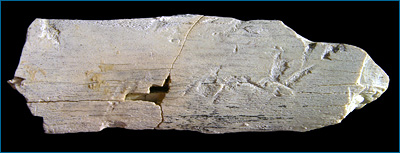When Jackson began his Ph.D. work at Rutgers University in 1999 he wanted to study fossil traces of predation by ancient hyenas, large cats, and canids such as jackals. However, as he began to dig into this topic, he couldn’t help but notice that another fearsome prehistoric predator that lived at Olduvai had been largely ignored. The bite marks made by terrestrial carnivores and scavengers like lions, hyenas, cheetahs, and rodents had been well documented. But what about crocodiles?

Many lines of evidence pointed to crocodiles’ potentially important role in the Olduvai ecosystem and, hence, their significance for understanding the evolution of our ancestors. The Leakeys had identified plenty of fossilized crocodile bones and teeth at Olduvai archaeological sites. Olduvai’s sedimentology and paleontological remains indicated that many of the early archaeological sites occurred in marshland settings along the edge of a saline-alkaline lake. Furthermore, studies of modern ecosystems similar to ancient Olduvai implied that crocodiles are a stronger predation threat in wetland environments than are terrestrial predators such as lions and hyenas. Despite this evidence, most previous analyses of predation in the Olduvai paleolandscape had ignored crocodiles and had focused instead on terrestrial carnivores and on distinguishing their feeding traces from butchery marks made by early humans.

To Jackson, it was clear that understanding crocodile feeding behavior and predation was important for understanding the threats and opportunities in early hominids’ environment, and not just at Olduvai. Jackson suspects that sites with signatures of crocodile activities are likely to be particularly important for understanding human evolutionary history in general: “Crocodiles live in water, and they ambush, kill, and feed on their prey in wetland settings. This is exactly the sort of environment from which archeologists and paleontologists are likely to find fossils. There are better conditions for the preservation of fossil material in underwater sediments than on dry land. And freshwater environments in this sort of arid savannah would draw all sorts of species — including humans. Early hominids probably went to such places to drink, hunt, and scavenge on carcasses abandoned by other predators on the margins of the wetlands — and we know that crocodiles must been there as well.” Run-ins between early hominids and ancient crocodiles seemed inevitable, and evidence of these interactions had a good chance of being preserved as fossils.
The first task, Jackson reasoned, was to figure out how to distinguish traces of crocodile predation from traces of predation by mammalian carnivores and from stone tool butchery by early hominids.
